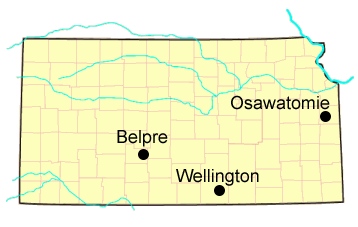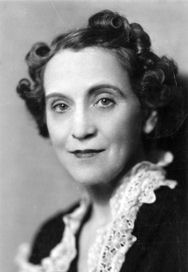| |
Mary Esma Williams, always called May, was born January 26, 1882, in Holden, Missouri, where her father worked as a bridge builder for the expanding Missouri Pacific Railroad. At the age of seven, the Williams family moved to Osawatomie, Kansas, her mother’s hometown. May graduated from Osawatomie High School in 1898 and earned a degree in mathematics from the University of Kansas in 1905. She married Merle Ward in 1908 in Osawatomie’s Old Stone Church that had been built by John Brown’s brother-in-law and nephew. And John Brown’s grandniece played the organ at their wedding.
The Wards moved wherever Merle’s grain elevator business took them, first to Lamar and Pueblo, Colorado, then to Spearville, Montezuma and Belpre, Kansas. When the Great Depression and the Dust Bowl put an end to his grain business, the couple moved to Wellington in 1933 where they took over ownership and management of his family’s hotel. The Wards remained in Wellington for the rest of their lives.
While still a resident of Montezuma, Ward received notice that the first poem she had ever submitted for publication was accepted by Life magazine. “Youth Wants Summer” appeared in Life’s February 17, 1921, issue. Soon, her poems were appearing in Ladies Home Journal, Good Housekeeping, Judge, Country Gentleman, American Magazine, the New York Sun and the Kansas City Star.
Within just four years, her talent was recognized nationally. In 1925, she received an invitation to spend a month at the MacDowell Colony in Peterborough, New Hampshire, and was there alongside Pulitzer Prize-winning poets Edwin Arlington Robinson, Stephen Vincent Benet and Sara Teasdale. By 1926, Ward had produced over 300 poems published in 35 magazines and was represented in four distinguished anthologies.
In 1926, Ward became editor of The Harp, a national poetry magazine published in Larned, Kansas. Other notable Kansans involved in this project included Leslie and Sara Wallace, William Allen White, Arthur Capper, Jouett Shouse, Birger Sandzen and Nell Lewis Woods.
Ward’s first book of poetry, Seesaw, was published in 1929. Also that year, Ward produced by hand another book, In Double Rhythm, which included around 30 poems, each accompanied by a block print designed and hand-carved by Ward to illustrate the rhythm and meaning of her verses. Five more books followed: From Christmas-Time to April (winner of the Kaleidograph book publication contest, 1938), Approach to Social Studies Through Choral Speaking (1945), Wheatlands (1954), No Two Years Alike (1960) and In That Day (1969).
Ward received The Poetry Society of America’s first place award on two different occasions, first in 1937 for a series of poems, “Dust Bowl,” and again in 1946 for “In That Day.”
William Allen White referred to Ward as “the champion poet of Kansas.” She left behind a legacy of over 2,000 poems and seven published books during a literary career that lasted fifty years. Ward died in 1975 at the age of 93.
---*Biography written by Lana Wirt Myers, author of Prairie Rhythms: The Life and Poetry of May Williams Ward, with thanks from the Center for Kansas Studies
Return to Top of Page |
|
|
| |
Writer
While bitter seeds scatter from the ruptured pod Earth
As wind words are a-mutter: death and death and death
While other too-ripe planets fall apart in rot
And spilled juice of comets spurts out hot
When lightnings roll tide-like west to east and back
And time’s wheel slipping sidewise jars the cosmic clock—
Someone will cling with one hand to a fragment bound for hell
While the other hand scrawls shorthand, reporting on it all.
A writer in his element, this “beat” his final glory:
His the one first-hand account of the great, the ultimate story.
---from In That Day,
1969
In That Day
And every island fled away
and the mountains were not found
nor were the rivers found;
the cities and the wheat-white plains
were swallowed underground
and the void sucked in the ground;
the oceans turned to flying mist
and vanished without sound
after that first great sound
and the race of men went with the rest
as Jahweh willed it should.
It was fitting that it should.
There was a nothingness of dark
where once the planets stood,
where once they sloped and stood,
and God looked on His handiwork
and saw that it was good—
the clean clear space was good. ---from In That Day, 1969
Return to Top
of Page
|
|
|





